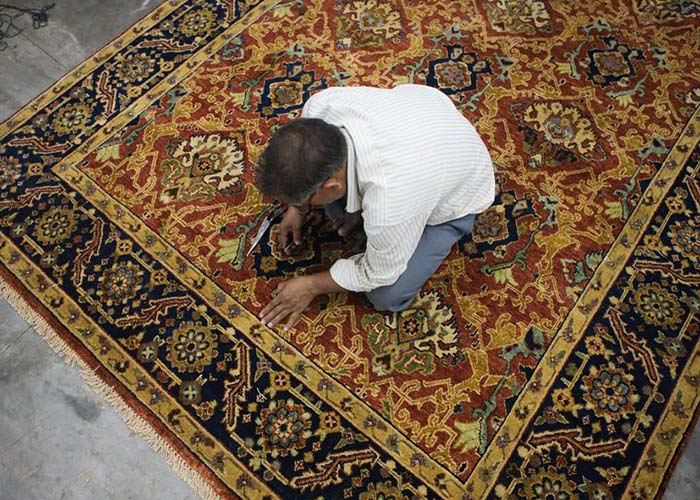
The process of weaving begins with the removal of fleece from the sheep with scissors. The wool is then washed, Cleaned, dried, and teased with a comb until it attains a soft, fine appearance similar to cotton candy. At this point, some wool is drawn and spun away from the fine ball of fiber until a thin strand can be attached to a spindle. The spindle is turned by hand, creating yarn and this thread may plied with another to form a stronger fiber. This hand-spun wool is highly desirable and yields a more irregular, roughly textured pile in which individual knots are more visible on the surface of the carpet.
Dying usually involves immersing yam in a mordant bath such as alum and then sleeping it in a boiling dye bath for several hours. When the dyer, a highly skilled craftsman, is finished, the colored wool is dried in the sun.
Tribal looms are simple and parable so they can be readily rolled up and transported from one place to another. Four wooden stakes are often driven into the ground several feet from each other to anchor two horizontal wooden poles that lie flat on the ground opposite one another. Many long warp threads are wrapped around these poles and form part of the foundation of the rug. Several rows of weft shoots arc woven over and under alternating warp threads al the end often loom to provide the foundation for the thousands of tiny knots to follow. When the knotting is completed at the other end, weft threads are again interlaced to bind and finish the carpets.
Village and city or town looms are larger and sturdier than tribal models and are usually upright. These vertical looms have strong side beams to support the opposing horizontal poles. The warp threads are tied around the poles. As the weavers progress, they may hoist themselves higher and higher on a bench until they finish at the top of the rug. Or, the carpet may be rolled up on the floor as more rows of knots are completed. A diagram or cartoon is often placed on the Ioom for the weavers to follow as they tie the knots.
A knot is made with a small tuft of wool about two inches long that is cut from a skein of yarn, which hangs from the loom. This thread is slipped over, under, and around two warp threads and forms a knot. The knots are looped one by one across the width of the loom. Between each row of knots one or more shoots of weft thread are interlaced across the width to hold the knots in place. The wefts are firmly compressed against the knots with a comb. Slowly, row after row of knots and wefts are completed and the rug is cut off the Ioom at the ends.
Warp threads may be braided together at the ends of the piece. It is not a flaw if they are bound together in a different manner on each end of the carpet. Then the rug is carefully and evenly sheared by skilled specialist. The finished carpet is finally washed, rinsed, dried, and slightly bleached in the sun to stabilize the dyes before being offered for sale.
Tribal weavings are generally all wool, and village rugs may have wool Pile with cotton or wool warps and wefts. Cotton is normally used for the warp and weft in city carpets. Both cotton and wool are highly durable fibers used for the foundation of rugs. Cotton wrap fringes are white or grey, and wool fringes may be cream, ivory, brown, or black.

